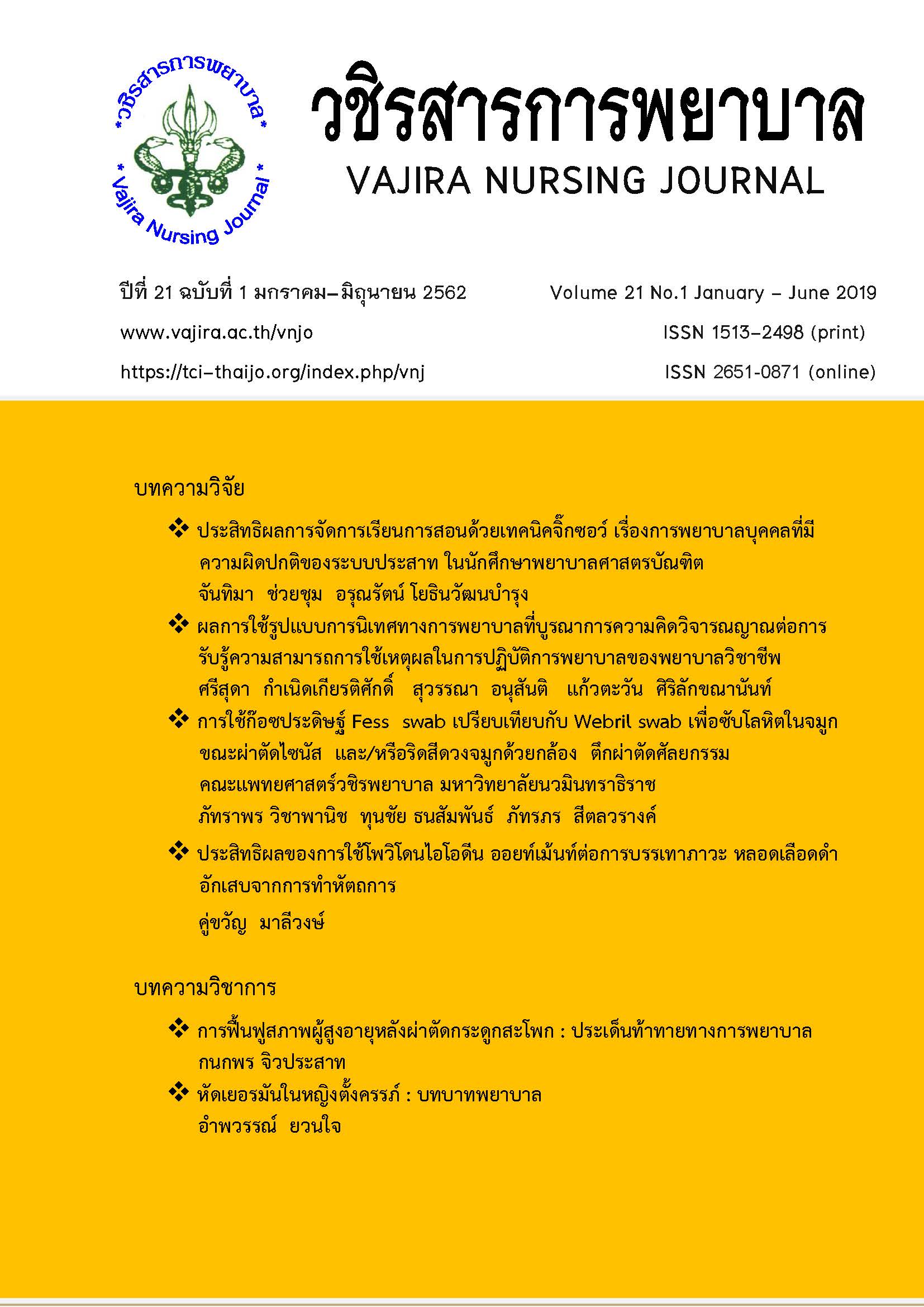การฟื้นฟูสภาพผู้สูงอายุหลังผ่าตัดกระดูกสะโพก : ประเด็นท้าทายทางการพยาบาล
Main Article Content
บทคัดย่อ
ผู้สูงอายุมีความเสี่ยงในการเกิดภาวะแทรกซ้อนภายหลังการผ่าตัดกระดูกสะโพกจากการไม่เคลื่อนไหว เนื่องจากผู้สูงอายุมีการเปลี่ยนแปลงทางสรีรวิทยาในทุกระบบของร่างกาย สภาวะสุขภาพก่อนการผ่าตัด ภาวะสมองเสื่อม ความสามารถในการทำหน้าที่ของร่างกาย ความแข็งแรงของกล้ามเนื้อ ระยะเวลารอก่อนทำผ่าตัด การผ่าตัด ความปวด ภาวะสับสนเฉียบพลัน ภาวะซึมเศร้า และความกลัวการหกล้ม การฟื้นฟูสภาพผู้สูงอายุหลังผ่าตัดกระดูกสะโพกเป็นบทบาทที่ท้าทายสำหรับพยาบาล การให้ความสำคัญในทุกระยะของการดูแลตั้งแต่ก่อนการผ่าตัด ระหว่างการผ่าตัด และภายหลังการผ่าตัด โดยการส่งเสริมภาวะโภชนาการ การคงความแข็งแรงของกล้ามเนื้อ การจัดการความปวด การป้องกันภาวะสับสนเฉียบพลัน การป้องกันการติดเชื้อภายหลังการผ่าตัด การป้องกันภาวะหลอดเลือดดำอุดตันที่ขา การป้องกันการเกิดข้อสะโพกเทียมเลื่อนหลุด การส่งเสริมความแข็งแรงของกล้ามเนื้อ โดยมีเป้าหมายเพื่อลดการเกิดภาวะแทรกซ้อนและส่งเสริมการเคลื่อนไหวร่างกายให้ใกล้เคียงก่อนการเกิดกระดูกสะโพกหักมากที่สุด
Article Details
เนื้อหาและข้อมูลในบทความที่ลงตีพิมพ์ในวชิรสารการพยาบาลถือเป็นข้อคิดเห็นและความรับผิดชอบของผู้เขียนบทความโดยตรง ซึ่งกองบรรณาธิการไม่จำเป็นต้องเห็นด้วย หรือร่วมรับผิดชอบใด ๆ ทั้งสิ้น
บทความ ข้อมูล เนื้อหา รูปภาพ ฯลฯ ที่ได้รับการตีพิมพ์ในวชิรสารการพยาบาล ถือเป็นลิขสิทธิ์ของวชิรสารการพยาบาล หากบุคคลใดหรือหน่วยงานใดต้องการนำทั้งหมดหรือส่วนหนึ่งส่วนใดไปเผยแพร่ต่อหรือเพื่อกระทำการใด ๆ จะต้องได้รับอนุญาตเป็นลายลักอักษรจากวชิรสารการพยาบาลก่อนเท่านั้น
เอกสารอ้างอิง
ดุจใจ กิติสมประยูรกุล. (2552). ตำราเวชศาสตร์ฟื้นฟู. กรุงเทพมหานคร: โรงพิมพ์แห่งจุฬาลงกรณ์มหาวิทยาลัย.
ไพรัช ประสงค์จีน. (2552). กระดูกหักและข้อเคลื่อน. (พิมพ์ครั้งที่ 4). กรุงเทพมหานคร: โรงพิมพ์แห่งจุฬาลงกรณ์มหาวิทยาลัย.
เรืองเดช พิพัฒน์เยาวกุล. (2560). ผลลัพท์หลังการเกิดกระดูกสะโพกหักในผู้สูงอายุที่เข้ารับการรักษา. วารสารการแพทย์โรงพยาบาลศรีสะเกษ สุรินทร์ บุรีรัมย์, 32(1), 21-32.
ลมัย สุวินทรากร. (2554). การพัฒนาแนวปฏิบัติการพยาบาลผู้ป่วยสูงอายุกระดูกสะโพกหักที่ได้รับการผ่าตัดเปลี่ยนข้อสะโพกเทียม. วารสารพยาบาลกระทรวงสาธารณสุข. 21(1), 22-32.
วรรณี สัตยวิวัฒน์. (2553). การพยาบาลผู้ป่วยออร์โธปิดิกส์. (พิมพ์ครั้งที่ 7). กรุงเทพมหานคร: ห้างหุ้นส่วนจำกัด เอ็นพีเพรส.
สัตยา โรจนเสถียร. Osteonecrosis of the Femoral Head. [เอกสารประกอบการสอน].สืบค้นจาก http://www.med.cmu.ac.th/dept/ortho/en/images/ education/Dr.Sattaya/AVN%20edit.pdf.
อภิสิทธิ์ ตามสัตย์. (2558). ความกลัวการหกล้มและความสามารถในการทำกิจกรรมของผู้สูงอายุหลังผ่าตัดกระดูกสะโพก. วารสารพยาบาลตำรวจ, 7(12), 64-79.
Andersson, L., Wesslau, A., Boden, H., & Dalen, N. (2001). Immediate or late weight bearing after uncemented total hip arthroplasty: a study of functional recovery. J Arthroplasty. 16(8), 1063-5.
Beaupre, L.A., Jones, C.A., Saunders, L.D., Johnston, D.W., Buckingham, J., & Majumdar, S.R. (2005). Best practices for elderly hip fracture patients. A systematic overview of the evidence. Journal of General Internal Medicine. 20(11), 1019-25.
Bech, N.H., Hulst, A.H., Spuijbroek, J.A., van Leuken, L.L.A., &Haverkamp, D. (2016) Perioperative pain management in hip arthroscopy; what options are there? .Journal of Hip Preservation Surgery. 3(3), 181-189.
Bjorkelund, K.B., Hommel, A., Thorngren, K.G., Gustafson, L., Larsson, S., &Lundberg, D. (2010). Reducing delirium in elderly patients with hip fracture: a multi-factorial intervention study. Acta Anaesthesiol Scand. 54(6), 678-88.
D'Angelo, F., Murena, L., Zatti, G., &Cherubino, P. (2008) The unstable total hip replacement. Indian Journal of Orthopaedics. 42(3), 252-9.
Dudda, M., Gueleryuez, A., Gautier, E., Busato, A., &Roeder, C. (2010). Risk factors for early dislocation after total hip arthroplasty: a matched case-control study. J Orthop Surg. 18(2), 179-83.
Harvey, N.R., Wolf, B.J., Bolin, E.D., &Wilson, S.H. (2017). Comparison of analgesia with lumba epidurals and lumbar plexus nerve blocks in patients receiving multimodal analgaesics following primary total hip arthroplasty: a retrospective analysis. International Orthopedics. 41, 2229-2235.
Inouye S.K. (2006). Delirium in older persons. N Engl J Med. 354(11), 1157-65. Kain H.B.(2000). Care of the older adult following hip fracture. Holist Nurs Pract.14(4),24-39.
Kammerlander, C., Gosch, M., Kammerlander-Knauer, U., Luger, T.J., Blauth, M., & Roth, T. (2011). Long-term functional outcome in geriatric hip fracture patients. Arch Orthop Trauma Surg. 131(10), 1435-44.
Klausmeier, V., Lugade, V., Jewett, B.A., Collis, D.K., &Chou, L-S. (2010). Is There Faster Recovery With an Anterior or Anterolateral THA? A Pilot Study. Clinical Orthopaedics and Related Research. 468(2), 533-41.
Lenguerrand, E., Wylde, V., Gooberman-Hill, R., Sayers, A., Brunton, L., Beswick, A.D., et al. (2016). Trajectories of Pain and Function after Primary Hip and Knee Arthroplasty: The ADAPT Cohort Study. PLoS One. 11(2).
Maher, A.B., Meehan, A.J., Hertz, K., Hommel, A., MacDonald, V., O’Sullivan, M.P., et al. (2012). Acute nursing care of the older adult with fragility hip fracture: An international perspective (Part 1).International Journal of Orthopaedic and Trauma Nursing.16(4),177-94.
Mak J.C., Cameron I.D., &March L.M. (2010). Evidence-based guidelines for the management of hip fractures in older persons: an update. The Medical Journal of Aust. 192(1), 37-41.
Mariconda, M., Galasso, O., Costa, G.G., Recano, P., &Cerbasi, S. (2011). Quality of life and functionality after total hip arthroplasty: a long-term follow-up study. BMC Musculoskelet Disord. 12(222), 1471-2474.
McGilton, K.S., Chu, C.H., Naglie, G., van Wyk, P.M., Stewart, S., &Davis, A.M. (2016). Factors Influencing Outcomes of Older Adults After Undergoing Rehabilitation for Hip Fracture. Journal of the American Geriatics Socreh. 64(8), 1601-9.
Menendez-Colino, R., Alarcon, T., Gotor, P., Queipo, R., Ramirez-Martin, R., Otero, A., et al. (2018). Baseline and pre-operative 1-year mortality risk factors in a cohort of 509 hip fracture patients consecutively admitted to a co-managed orthogeriatric unit (FONDA Cohort). Injury. 49(3), 656-61.
Muir, S.W., Yohannes, A.M. (2009). The impact of cognitive impairment on rehabilitation outcomes in elderly patients admitted with a femoral neck fracture: a systematic review. Journal Geriatric Physical Therapy. 32(1), 24-32.
Olofsson, B., Lundstrom, M., Borssen, B., Nyberg, L., &Gustafson, Y. (2005). Delirium is associated with poor rehabilitation outcome in elderly patients treated for femoral neck fractures. Scand J Caring Sci. 19(2), 119-27.
Oude Voshaar, R.C., Banerjee, S., Horan, M., Baldwin, R., Pendleton, N., Proctor, R., et al. (2006). Fear of falling more important than pain and depression for functional recovery after surgery for hip fracture in older people. Psychol Med. 36(11), 1635-45.
SooHoo, N.F., Farng, E., Chambers, L., Znigmond, D.S., &Lieberman, J.R. (2013). Comparison of complication rates between hemiarthroplasty and total hip arthroplasty for intracapsular hip fractures. Orthopedics. 36(4).
Visser, M., Harris, T.B., Fox, K.M., Hawkes, W., Hebel, J.R., Yahiro, J.Y., et al. (2000). Change in muscle mass and muscle strength after a hip fracture: relationship to mobility recovery. J Gerontol A Biol Sci Med Sci. 55(8), M434-40.
Wallace, S., & Ellington, B.J. (2014). Factors Affecting Postsurgery Hip Fracture Recovery. Journal of Orthopaedics, Trauma and Rehabilitation. 18(2), 54-8.


